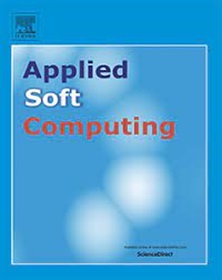基于多智能体合作的双准则进化多目标优化
IF 6.6
1区 计算机科学
Q1 COMPUTER SCIENCE, ARTIFICIAL INTELLIGENCE
引用次数: 0
摘要
多目标进化算法(maoea)擅长解决多目标优化问题(MaOPs),主要分为两种框架:Pareto控制和非Pareto控制。Pareto准则(PC)通过解之间的Pareto优势关系得到多目标空间中一个良好收敛的解集。然而,在多目标空间中,环境选择压力不足导致收敛缓慢。非帕累托准则(NPC)通过使用一组可排序的标量值来评估解集,从而提高了选择压力。然而,面对高度不规则的帕累托锋面时,很难保证收敛和分布的帕累托最优一致性。因此,将两套准则结合使用可以满足均匀分布的要求,同时带来较大的选择压力。本文提出了一种多智能体合作策略来实现这两个准则的结合。该策略通过部署两个agent分别控制两个种群的进化方向,并通过大量信息的交换和流动促进种群之间的合作进化。为了更好地实现协同效果,采用多智能体强化学习(MARL)策略对双种群的变异算子和参数配置进行精确调节。此外,在74个测试问题(DTLZ、WFG和UF)和3个实际问题上验证了所提出方法的有效性。结果表明,该算法比现有的6种算法更具竞争力。本文章由计算机程序翻译,如有差异,请以英文原文为准。
Multi-agent cooperation-based bi-criteria evolutionary many-objective optimization
Many-objective evolutionary algorithms (MaOEAs) excel in solving many-objective optimization problems (MaOPs), which are mainly classified into two frameworks: the Pareto domination and the non-Pareto domination. The Pareto criterion (PC) obtains a well-converged solution set in multi-objective spaces through the Pareto dominance relationship between solutions. However, insufficient environmental selection pressure in many-objective spaces leads to slow convergence. The non-Pareto criterion (NPC) enhances the selection pressure by evaluating the solution set with a set of sortable scalar values. However, it is difficult to ensure the Pareto-optimal consistency of convergence and distribution when facing highly irregular Pareto fronts (PFs). Therefore, combining the two sets of criteria can satisfy the demand for uniform distribution while bringing significant selection pressure. A multi-agent cooperative strategy is proposed in this study to realize the combination of the two criteria. This strategy controls the evolutionary direction of two populations separately by deploying two agents, and promotes cooperative evolution between these populations through the exchange and flow of large amounts of information. In order to better realize the cooperative effect, we adopt the multi-agent reinforcement learning (MARL) strategy to accurately regulate the variation operator and parameter configurations of the bi-population. In addition, the effectiveness of the proposed method is validated on 74 test problems (DTLZ, WFG, and UF) and 3 real-world problems. The results show that the proposed algorithm is more competitive than 6 state-of-the-art algorithms.
求助全文
通过发布文献求助,成功后即可免费获取论文全文。
去求助
来源期刊

Applied Soft Computing
工程技术-计算机:跨学科应用
CiteScore
15.80
自引率
6.90%
发文量
874
审稿时长
10.9 months
期刊介绍:
Applied Soft Computing is an international journal promoting an integrated view of soft computing to solve real life problems.The focus is to publish the highest quality research in application and convergence of the areas of Fuzzy Logic, Neural Networks, Evolutionary Computing, Rough Sets and other similar techniques to address real world complexities.
Applied Soft Computing is a rolling publication: articles are published as soon as the editor-in-chief has accepted them. Therefore, the web site will continuously be updated with new articles and the publication time will be short.
 求助内容:
求助内容: 应助结果提醒方式:
应助结果提醒方式:


